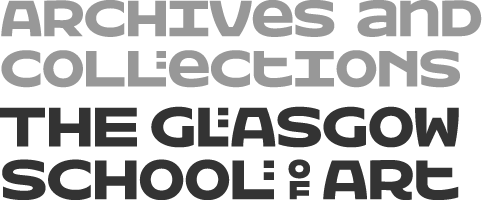Frances Macdonald’s achievements are less well known than those of her sister, Margaret Macdonald. In part this is due to the loss of much of her work, destroyed by her husband, Herbert McNair, after her death, and in part to the fact that she left Glasgow in 1899. Nonetheless she produced some of the most powerful imagery of the Glasgow Style, and her late symbolist watercolours are moving meditations on the choices facing women.
Frances was born in England and moved to Glasgow with her family by 1890. She enrolled as a student at Glasgow School of Art recording her address as 9 Windsor Terrace, Glasgow.
GSA records reveal a successful school career:
1891: Local exam., advanced, Stage 23c, ornamental design, 2nd class
1891: Local exam., advanced, Stage 10a, plant drawing in outline, 2nd class
1891: Local exam, 2nd grade certificate, freehand drawing, 2nd class
1892: National Competition, Bronze medal, Stage 23d, des for majolica plate
1892: Local exam, advanced, composition from given figure subject, 2nd class
1892: Local exam, advanced, painting in monochrome, 1st class
1892: Local exam, advanced, design, honours stage, 1st class
1892: Local competition, design, majolica, prize
1893: Local exam, advanced, drawing from the antique, 2nd class
1893: Local exam, advanced, design, honours stage, 1st class
1893: Local exam, advanced, principles of ornament, 2nd class
1893: Local exam, advanced, model drawing, 1st class
1893: Local exam, advanced, drawing in light and shade, 1st class
1893: Local competition, design section, hangings, 1st prize 1908/10 1908/10: art needlework and embroidery, design and instruction 1908/10: enamels, design 1908/10: gold and silversmithing, design 1908/10: metalwork, repousse &c, design
GSA Staff, Design Dept 1908/10
1908/10: art needlework and embroidery, design and instruction
1908/10: enamels, design
1908/10: gold and silversmithing, design
1908/10: metalwork, repousse &c, design
It was at GSA that she met Charles Rennie Mackintosh and Herbert McNair. In the mid 1890s Frances left the School and set up an independent studio in the city centre with her sister, Margaret Macdonald. Together they collaborated on metalwork, graphics, textile designs and book illustrations, exhibiting in London, Liverpool and Venice.
Following her marriage in 1899 to Herbert McNair she joined him in Liverpool where McNair was by then teaching at the School of Architecture and Applied Art. The couple designed the interiors of their home at 54 Oxford Street and exhibited a Writing Room at the International Exhibition of Modern Art, Turin. Macdonald also started teaching, and developed skills in jewellery, enamelwork and embroidery. The closure of the School in the early 1900s led to a gradual decline in their careers, compounded by the loss of the McNair family wealth through business failures. The couple returned to Glasgow around 1909. It was in the following years that Macdonald painted a moving series of symbolist watercolours addressing themes related to marriage and motherhood. She died in Glasgow in 1921.
For further information consult ed. Jude Burkhauser, ‘Glasgow Girls’, Canongate Press, 1990 and Janice Helland, ‘The Studios of Frances Macdonald and Margaret Macdonald’, Manchester University Press, 1995. An exhibition of the McNairs’ work was held at the Hunterian Art Gallery, University of Glasgow, in the summer of 2006, subsequently touring to the Walker Art Gallery, Liverpool from January to April 2007.
